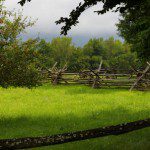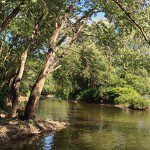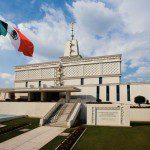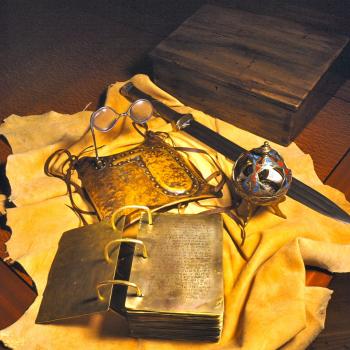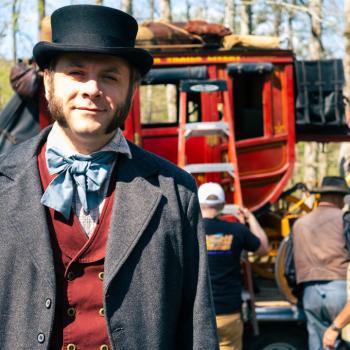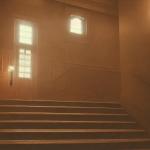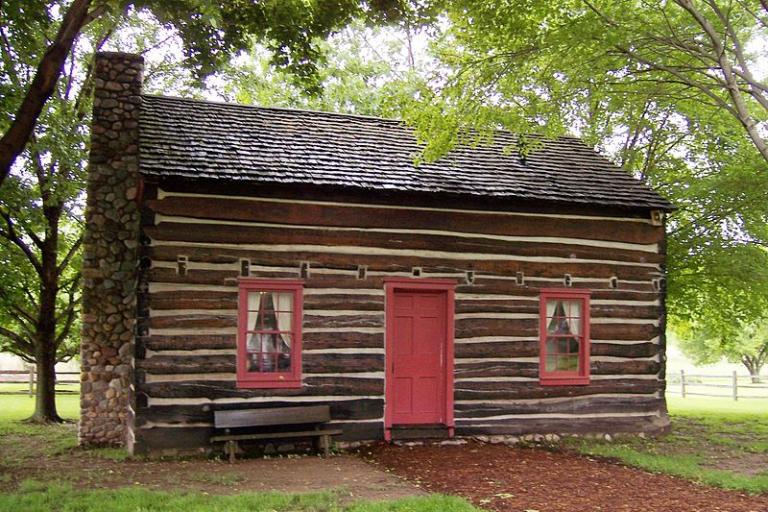
(Wikimedia Commons public domain image)
I was pleasantly surprised to run into the core Interpreter Foundation filmmaking team — Mark Goodman, James Jordan, and Russ Richins, along with their frequent collaborator Rhett Fernsten — in the lobby of our hotel this morning. They’ve been down in Tennessee doing the final scene for Six Days in August, and I had somehow thought that they were going from there to Upper Canada Village, in Ontario. I was wrong, though: They are filming a few additional minutes at the Genesee Country Village and Museum, just outside of Rochester. It was fun to find out that they’re staying in the same hotel that we are. They report being very pleased with the footage that they’ve recently generated.
We attended church this morning in the beautiful chapel that is stands near to the Palmyra New York Temple. Afterwards, we did some filming around the Frame Home on the Joseph Smith Family Farm there. and then we continued our work at the Peter Whitmer Farm near Fayette, New York. Steven C. Harper joined with Casey Griffiths and me for enjoyable filmed discussions in both Palmyra and Fayette. In Palmyra today, we spoke mainly about the experience of the Eight Witnesses, which occurred on or near the Smiths’ farm. In Fayette, we discussed the Three Witnesses, who saw the angel and the plates and other ancient artifacts — and heard the voice of God — somewhere on or near the Whitmer farm.
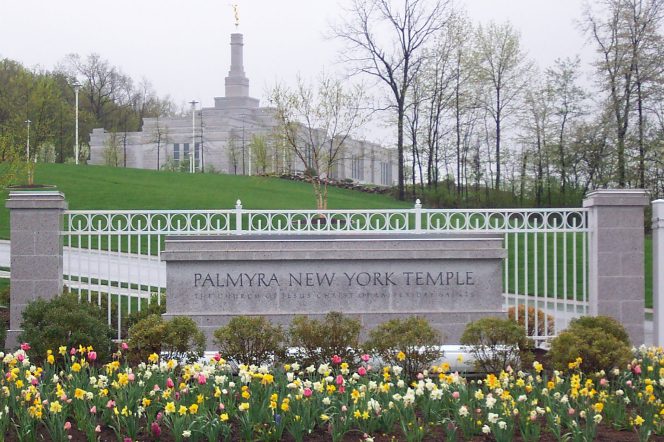
It’s been another long and surprisingly exhausting day, and it’s getting late. So I think that I will share, here, three accounts taken from my recent reading of William J. Peters, with Michael Kinsella, At Heaven’s Door: What Shared Journeys to the Afterlife Teach about Dying Well and Living Better (New York and London: Simon and Schuster, 2022):
And then, as I was looking toward the window, I had this image of this golden light and Dad with his two brothers and his mom and their arms around each other, walking away, and he was looking back over his shoulder, like, Yeah, it’s okay. I’m good. They were all young, and he was wearing his army uniform. It was interesting because the pictures that we have of his mother are all from when she’s older. I remember that it struck me that I didn’t know if I ever saw a picture of her at that age, but there she was. He always described her as being very careworn because of the multiple jobs and the economic stress. But she didn’t look careworn, she looked healthy and happy. Dad had his arm around his brother Martin on one side and his mother on the other. And his brother Sam was on the other side, but they were all arm in arm, the four of them walking away. The whole scene was just like a movie, where there’s this gold light, not super bright, but you could see it’s brighter there, and everybody’s smiling and happy and there was a message of Okay, it’s time to go. (164, italics in the original)
The bright, golden light is a striking feature of the preceding account. Such light, described in pretty much those terms, is a very striking element in many near-death accounts. Often, the light is golden. Often, it’s perceived as white.
What Amelia saw “was a woman walking toward what I thought was me. I didn’t think she was coming toward Tom, because she just appeared. I watched her, and I thought, ‘She’s a beautiful young woman. She’s so beautiful.’ And I remember thinking, ‘I must remember this. I must remember this. I must remember that she’s beautiful.’ She had a pale face and a sort of slightly pointy chin; her face was like a heart. Very pronounced cheekbones. She wasn’t anybody I recognized. She had long, dark hair that was like what women wore in the seventies, a Joni Mitchell or someone like that. And I always leave this bit out, because I think people will think I’m mad, but she was wearing like a gown. A proper gown in white. I think she might’ve been holding something in her hand. . . .
“She was walking quickly, with purpose and with intent. She appeared solemn, strong, and wise.
“Then I looked at what she was walking through, and it was a tunnel. I find it really difficult to describe that tunnel, because it was dark. But there was light shining through it. If I looked at the walls of that tunnel, it wasn’t brick or cement. It was like air. But it was solid. So the only way I can compare it to something is that it would be like a cloud. A dark storm cloud looks quite solid, but you can see the sun behind the cloud trying to break through, and when it does, you know the sun’s out. And that’s what it felt like.
“Now that I’ve read so many books on death, I know everyone talks about tunnels. But I hadn’t read those books then. I was just reading normal books. And I remember seeing the tunnel and out of the corner of my eye, I could almost see this incredibly intense white light. And I knew that white light was really good. I knew everything was okay, because of this intense white light. (178-179)
Again, light. Light that somehow conveys goodness and safety. And, of course, the famous tunnel.
And now I’m going to tell you the reason why I didn’t answer the phone: because my soul had left my body. My soul was with my husband, and I am absolutely convinced of it. I have no scientific proof, but for me, it’s perfectly obvious. I found myself behind my husband, who is going up into the blue sky. And there’s this feeling of perfect beatitude. It was perfect, perfect peace, kind of what I saw in his face when I walked into his room that morning. In this experience, I couldn’t see his face exactly. It wasn’t as if I could see my husband physically, but I was following him into the heavenly spheres, into blue light and white clouds. I don’t know how high I was, but I was up there with him, and I kept following him and following him. And at one point, I made the decision to come back. I’m sure I didn’t actually have the choice; I think I had to come back. If I didn’t, I would have to die. So I had the consciousness that if I continued to go with him, then that would be my end. There was no fear, I just said, ‘I don’t think I can go any further for the moment.’ Then I turned around, and it was as if I could see the earth from hundreds of thousands of kilometers from where I was. If you’ve ever studied the Old Masters, Hieronymus Bosch, or Brueghel in the Renaissance, they drew all kinds of weird things, horrible things on earth. I turned around, and I see the earth the way I’ve never seen the earth in my entire life. I saw all this treason and treachery; it was almost like I was looking at hell, although I didn’t think that at the time. . . . [I]t was absolute, perfect bliss, something I had never felt before and have never felt again. (188-189)
Posted from Rochester, New York


